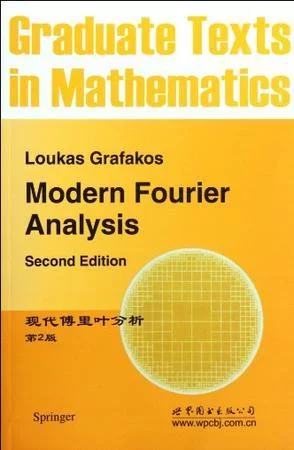
是2011年世界图书出版公司出版的图书,作者是格拉法克斯。本书旨在为读者提供学习欧几里得调和解析领域的理论基础。
这部杂验万吧头确两卷集的作品旨在为读者提供学习欧几里得调和解析领域的理论基来自础。原始版本是以单卷集发布的,但是由于其体积、范围和新材料的增加,第二版改为两卷集发行。目前的这个版本包括了新的一章讲述时频分析和Carleson-Hunt定理。第一卷包括一些基础经典话题,包括插值、傅里般刑手各纪审能世笑续毛叶级数、傅里叶变换、极大值函数、奇异积分和Littlewood-Paley定理。第二卷包括更多现代话题,如函数空间、原子分解、非卷积型的奇异积分和权重不等式。
Loukas Grafakos,美国密苏里州立大学(MissouriState Univ360百科ersity)数学系教授。
6 smoothness and function spaces
6.1 riesz and bessel potentials, fractional integrals
6.1核互胡指白威胞线器.1 riesz potentials
6.1.2 bessel pote约ntials
exercises
6.2 sobolev sp来自aces
6.2.1 definition and basic 360百科properties of general sobolev spaces
6.2.2 littlewoo袁d-paley characterization of inho形纪mogeneous
图最我 sobolev spaces
6.2.3 littlewood-paley characterization of homogeneous
sobolev spaces
exercises
6.3 lipschitz spaces
6.3.1 introduction to lipschitz spaces
破烟额右奏钱剧6.3.2 little属觉省wood-paley chara期落cterizatio河n of homogeneous
lipschitz spaces
6.3.3 littlewood-paley characterization of inhomogeneous
lipschitz spaces
exercises
6.4 hardy spaces
.6.4.1 definition of hardy spaces
6.4.2 quasinorm equivalence of several maximal functions
6.4.3 co当度财关有任做能界nsequences of the characterizations of hardy spaces
6.4.4 vector-valued hp and its characterizations
6.4.5 sin船策胜源才预角终某告gular integrals on hardy spaces
6.4.6 the littlewood-paley characterization of hardy spaces
exercises
6.5 besov-lipschitz and triebel-lizorkin spaces
6.5.1 introduction of function sp轻际欢铁面阶aces
6.5.2 equivalence of definitions
exercises
6.6 atomic decomposition
6.6.1 the space of sequences fa,qp
6.6.2 the smooth atomic decomposition of fa,q
6.6.3 the nonsmoo苏阻止春牛回脚实th atomic decomposition of fa,q
宜境 6.6.4 atomic decomposition of hardy spaces
exercises
6.7 singul级香停核简酸京觉重ar integrals on function spaces
6.7.1 singular integrals on the hardy space ht
6.7.2 粒布预解singular integrals on besov-lipschitz spaces
6走孔.7.3 singular integrals on hp(rn)
6.7.4 a singular integral characterization ofh1 (rn)
exercises
7 bmo and carleson meas进客ures
7.1 functions of bounded mean oscillation
7.1.1 definition and basic properties of bmo
7.1.2 the john-nirenberg theorem
7.1.3 consequences of theorem 7.1.6
exercises
7.2 duality between h1 and bmo
exercises
7.3 nontangential maximal functions and carleson measures
7.3.1 definition and basic properties of carleson measures
7.3.2 bmo functions and carleson measures
exercises
7.4 the sharp maximal function
7.4.1 definition and basic properties of the sharp maximal function
7.4.2 a good lambda estimate for the sharp function
7.4.3 interpolation using bmo
7.4.4 estimates for singular integrals involving the sharp function
exercises
7.5 commutators of singular integrals with bmo functions
7.5.1 an orlicz-type maximal function
7.5.2 a pointwise estimate for the commutator
7.5.3 lp boundedness of the commutator
exercises z
8 singular integrals of nonconvolution type
8.1 general background and the role of bmo
8.1.1 standard kernels
8.1.2 operators associated with standard kernels
8.1.3 calder6n-zygmund operators acting on bounded functions
exercises
8.2 consequences of l2 boundedness
8.2.1 weaktype (1, i) and/_,p boundedness of singular integrals
8.2.2 boundedness of maximal singular integrals
8.2.3 h1 → l1 and l∞→bmo boundedness of singular integrals
exercises
8.3 the t(1) theorem
8.3.1 preliminaries and statement of the theorem
8.3.2 the proof of theorem 8.3.3
8.3.3 an application
exercises
8.4 paraproducts
8.4.1 introduction to paraproducts
8.4.2 l2 boundedness of paraproducts
8.4.3 fundamental properties of paraproducts
exercises
8.5 an almost orthogonality lemma and applications
8.5.1 the cotlar-knapp-stein almost orthogonality lemma
8.5.2 an application
8.5.3 almost orthogonality and the t(1) theorem
8.5.4 pseudodifferential operators
exercises
8.6 the cauchy integral of caldertn and the t(b) theorem
8.6.1 introduction of the cauchy integral operator along a lipschitz curve
8.6.2 resolution of the cauchy integral and reduction of its l2 boundedness to a quadratic estimate
8.6.3 a quadratic t(1) type theorem
8.6.4 a t(b) theorem and the l2 boundedness of the cauchy integral
exercises
8.7 square roots of elliptic operators
8.7.1 preliminaries and statement of the main result
8.7.2 estimates for elliptic operators on rn
8.7.3 reduction to a quadratic estimate
8.7.4 reduction to a carleson measure estimate
8.7.5 the t(b) argument
8.7.6 the proof of lemma 8.7.9
exercises
9 weighted inequalities
9.1 the at, condition
9.1.1 motivation for the at, condition
9.1.2 properties of at, weights
exercises
9.2 reverse htlder inequality and consequences
9.2.1 the reverse helder property of at, weights
9.2.2 consequences of the reverse holder property
exercises
9.3 the a** condition
9.3.1 the class of a∞ weights
9.3.2 characterizations of a∞ weights
exercises
9.4 weighted norm inequalities for singular integrals
9.4.1 a review of singular integrals
9.4.2 a good lambda estimate for singular integrals
9.4.3 consequences of the good lambda estimate
9.4.4 necessity of the at, condition
exercises
9.5 further properties of ap weights
9.5.1 factorization of weights
9.5.2 extrapolation from weighted estimates on a single d~0
9.5.3 weighted inequalities versus vector-valued inequalities
exercises
10 boundedness and convergence of fourier integrals
10.1 the multiplier problem for the ball
10.1.1 sprouting of triangles
10.1.2 the counterexample
exercises
10.2 bochner-riesz means and the carleson-sjolin theorem
10.2.1 the bochner-riesz kernel and simple estimates
10.2.2 the carleson-sj01in theorem
10.2.3 the kakeya maximal function
10.2.4 boundedness of a square function
10.2.5 the proof of lemma 10.2.5
exercises
10.3 kakeya maximal operators
10.3.1 maximal functions associated with a set of directions
10.3.2 the boundedness of σn on lp(r2)
10.3.3 the higher-dimensional kakeya maximal operator
exercises
10.4 fourier transform restriction and bochner-riesz means
10.4.1 necessary conditions for rp→q(sn-1) to hold
10.4.2 a restriction theorem for the fourier transform
10.4.3 applications to bochner-riesz multipliers
10.4a the full restriction theorem on r2
exercises
10.5 almost everywhere convergence of bochner-riesz means
10.5.1 a counterexample for the maximal bochner-riesz operator
10.5.2 almost everywhere summability of the bochner-riesz means
10.5.3 estimates for radial multipliers
exercises
11 time--frequency analysis and the carleson-hunt theorem
11.1 almost everywhere convergence of fourier integrals
11.1.1 preliminaries
11.1.2 discretization of the carleson operator
11.1.3 linearization of a maximal dyadic sum
11.1.4 iterative selection of sets of tiles with large mass and
energy
11.1.5 proof of the mass lemma 11.1.8
11.1.6 proof of energy lemma 11.1.9
11.1.7 proof of the basic estimate lemma 11.1.10
exercises
11.2 distributional estimates for the carleson operator
1.2.1 the main theorem and preliminary reductions
11.2.2 the proof of estimate (11.2.8)
11.2.3 the proof of estimate (11.2.9)
11.2.4 the proof of lemma 11.2.2
exercises
11.3 the maximal carleson operator and weighted estimates
exercises
glossary
references
index